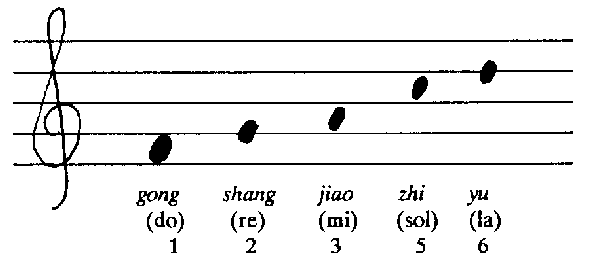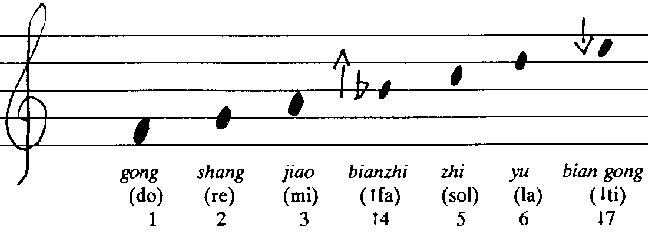

The Chinese names and sol-fa syllables stand for the position of each tone in the scale rather than specific pitches. In the performance practice of xian shi yue, however, Teochiu musicians have established the pitch of gong, or do, as F.
In addition to the five tones shown
above, two other tones are used as passing tones or to achieve
modal changes within the basic pentatonic framework. The scale
degrees, bian zhi, (raised 4), and
bian gong (lowered 7 ), are called bianyin ("changing tones"). They
are interchanged with
jiao (3) and yu (6) respectively as ornamental tones
in various modes. Xian shi yue thus accesses seven tones in performance, though
only five at a time (score below). Other Chinese regional folk musics may also access
seven tones. But the seven-tone scale used in
xian shi yue differs by its prominent use of the two "changing tones" and the
ornamentation
with which these and other tones are executed.

In theory, the intonation of the two changing tones shown above fall at about three- fourths the distance of the whole tone interval between the pitches A and B (bianzhi), and between D and E (bian gong). In performance, these pitches vary, depending on melodic and modal contexts. A musician normally executes a vibrato on these two changing tones. The performer also makes slight variations in the pitches toward which these tones may tend, depending on such factors as the mode and whether the melody is ascending or descending when the tone occurs.
In a piece in the zhongsan zhongliu mode, for instance, the fourth degree, raised Bb, may be played slightly sharp, almost B-natural, in an ascending melodic line. It reverts back to the usual raised Bb again in a descending melodic line. In a piece in the huowu mode, the fourth degree becomes slightly flat, approaching Bb.
Mercedes DuJunco